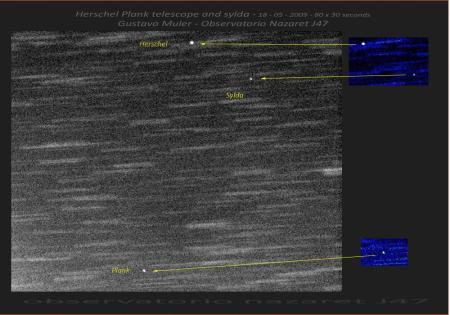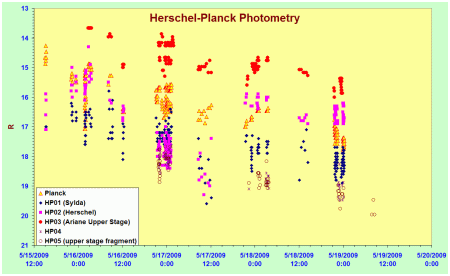[cross-posted from Planck UK site]
Last week, the Planck satellite observed the Crab Nebula, also known as M1 from Messier’s catalogue, and Tau A to radio astronomers. The Crab Nebula is one of the brightest objects in the sky at radio and sub-mm wavelengths, and is used by many astronomers to calibrate their instruments. It is the remnants of a star which underwent a violent and catastrophic explosion at the end of its life, an event known as a supernova. The Crab Nebula is associated with one of the few supernovae which was observed, as it was seen by Chinese and Arab astronomers in 1054.
After the supernova, the outer layers of the star were scattered widely into a huge cloud of gas, which we now see as a nebula, and is frequently observed by amateur and professional astronomers. The core of the star ended up as a pulsar, a rapidly rotating, magnetised neutron star. However, it is the surrounding nebula that Planck is interested in. The nebula is around 13 lightyears across, which is around 10,000 times larger than our solar system (depending on where you define the edge). It is also relatively close in astonomical terms, at about 6 lightyears distance, and so is also relatively large in terms of astronomical objects see from Earth. It is around 7 arcminutes across, which is 7/60th of a degree, or about 1/4 the diameter of the full moon as seen from Earth. The smallest of Planck’s beams on the sky is 5 arcminutes and the largest 30 arcminutes, so to the majority of Planck’s detectors the Crab Nebula will have appeared as a “point source” – a single blip in the data. However, it is so bright that it would still be very obvious.
Because the central pulsar is magnetised, the Crab Nebula is permeated by a magnetic field. This causes any electrons in the nebula, of which there are many, to spiral around the magnetic field lines and emit radiation known as synchrotron radiation. This radiation, which is brightest at radio wavelengths, but still very strong at Planck frequencies, is polarised, which makes the Crab an ideal object for calibrating the polarisation-sensitive detectors on Planck. Many experiments have observed its polarised radiation, including the SCUBA instrument on the JCMT on Hawaii, which observed it at 350GHz (a wavelength of 850 microns). One of the properties of synchrotron radiation is that it varies in a fairly predictable way with frequency, so it is possible to tell from an observation at one frequency what it will look like at another.
The data will take time to analyse, but will be ingested into the Planck database and used to help calibrate its instruments. The Crab Nebula is not the only calibration source, but is the best single source in the sky for calibrating the polarisation angles. Other non-polarised sources include the planets in our own solar system, particularly Jupiter, which are very bright at Planck’s frequencies as well as to the naked eye.



